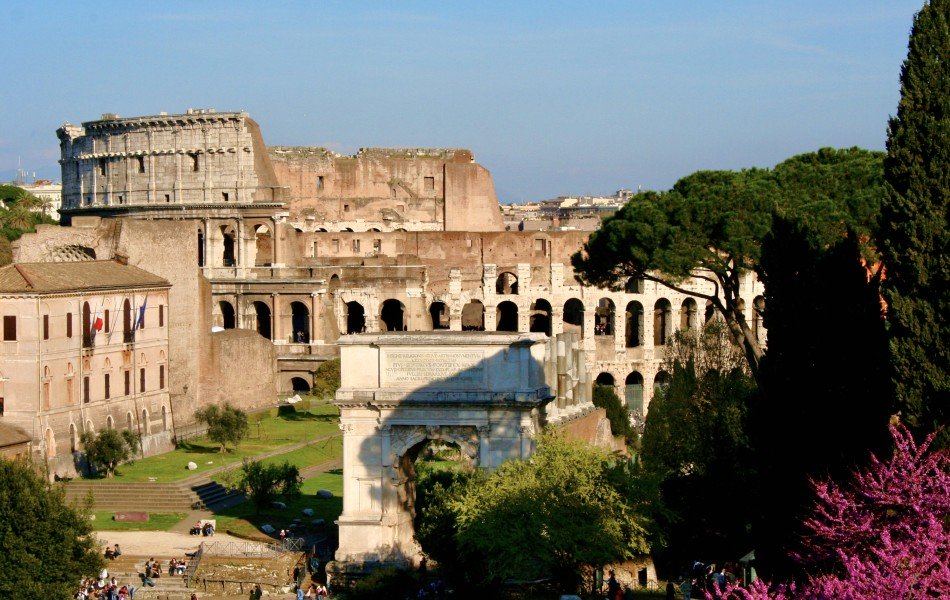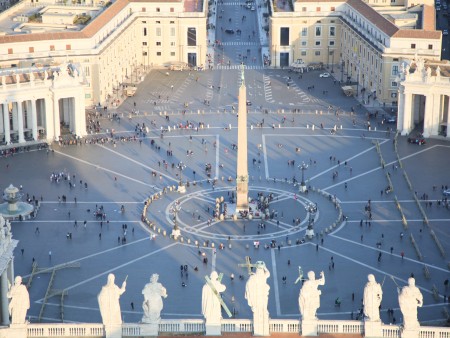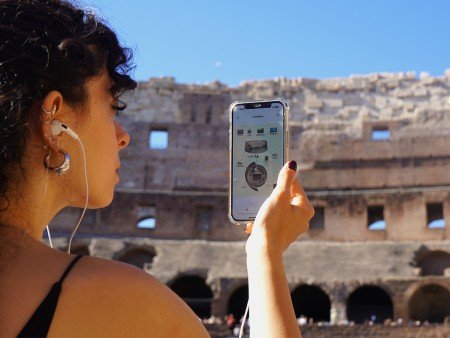Rome's Timeless Heart: Where the Past Unfolds at Every Step
Step into a Living Museum of History, where the Colosseum, Roman Forum, Pantheon, and Piazza Navona Whisper Timeless Tales

25 July 2024
Rome Travel GuideThe historic center of Rome is a living museum, where time seems to fold in on itself and history emerges at every corner. It’s a place where emperors, popes, and artists left their indelible marks, creating a tapestry of timeless stories woven into the city’s ancient stones.
1. Colosseum
The Colosseum, a monumental icon of ancient Rome, stands as a testament to the grandeur and ingenuity of a civilization at its peak. Completed in 80 AD, this colossal amphitheater once thrummed with the excitement of gladiatorial contests and extravagant public spectacles, drawing crowds from all walks of life.
As you stand before its towering arches and intricate details, the echoes of history seem to whisper tales of bravery, sacrifice, and the roaring cheers of thousands. It was a stage where life and death intertwined, showcasing not just the might of the Empire but also its complex social dynamics.
Even today, the Colosseum invites admiration and reflection, serving as a poignant reminder of the rich tapestry of Roman culture. It embodies the spirit of an era long past, inspiring awe and curiosity in all who encounter its enduring legacy.
2. Roman Forum
The Roman Forum, once the bustling heart of ancient Rome, is a captivating glimpse into the political, social, and religious life of a civilization that shaped the world. Surrounded by majestic ruins and crumbling temples, this expansive site was the epicenter of public life, where monumental decisions were made, orators delivered impassioned speeches, and citizens gathered to witness celebrations of triumph and ritual.
As you stroll through the remnants of the Senate House, the Temple of Vesta, and the Arch of Titus, the whispers of history echo around you. The Forum served as a stage for both grand victories and everyday interactions, illustrating the complexity of Roman society. Each stone tells a story of power, ambition, and the intricate web of relationships that defined an empire.
Today, the Forum stands as a powerful symbol of Rome’s rich heritage, inviting visitors to reflect on the enduring influence of its past. With its breathtaking vistas and profound historical significance, the Roman Forum remains a timeless testament to the legacy of a civilization that continues to inspire wonder and fascination.
3. Palatine Hill
Palatine Hill, one of the seven hills of Rome, is a cradle of myth and history, revered as the birthplace of the city itself. Standing at the center of the ancient world, it was once the residence of emperors and the elite, boasting sprawling palaces and lush gardens that whispered tales of opulence and power. The remnants of grand structures, like the House of Augustus and the Palatine Palace, evoke a sense of awe, inviting visitors to imagine the vibrant life that once thrived here.
As you stroll along its pathways, the panoramic views of the Roman Forum and the Colosseum unfold before you, offering a breathtaking perspective of the city’s layered history. The air is thick with stories of triumph and tragedy, from the legendary founding of Rome by Romulus to the political intrigues of emperors.
Palatine Hill is more than a historical site; it is a serene oasis in the heart of the bustling city, where the echoes of the past come alive, inspiring reflection and appreciation for the remarkable legacy of ancient Rome.
4. Piazza del Campidoglio
Perched atop Capitoline Hill, Piazza del Campidoglio is a masterpiece of Renaissance architecture designed by Michelangelo, blending classical grandeur with modern vision. Completed in the 16th century, the square is framed by three elegant palazzi, their facades harmonizing to create a perfect balance of symmetry and space. At the center stands the majestic equestrian statue of Marcus Aurelius, symbolizing the enduring power of Rome.
As you step onto the patterned paving, it feels as though time itself bends to the will of art and history. Once the heart of ancient Roman governance, this hill has long been a seat of power, and the piazza continues to emanate a sense of authority and cultural significance. The views from the edge, where the city sprawls below, offer a stunning reminder of Rome’s layered history—from its imperial past to its vibrant present.
Piazza del Campidoglio is more than just a square; it’s a testament to Rome’s ability to seamlessly blend its ancient legacy with Renaissance innovation, inviting reflection on the city’s timeless capacity to inspire awe.
5. Pantheon
As you approach its grand portico, with its towering columns and massive bronze doors, there’s an undeniable sense of reverence. Stepping inside, the oculus at the dome's apex invites a celestial beam of light, illuminating the space in a dance of shadows and brilliance. This remarkable interplay of light creates an ethereal atmosphere, reminding visitors of the divine connection the Pantheon once embodied.
The interior is adorned with intricate marble and grand tombs, including that of the renowned artist Raphael, weaving together art and history in an unforgettable tapestry. The Pantheon transcends its physical form, representing not only architectural prowess but also the enduring spirit of Roman culture. It stands as a poignant reminder of a civilization that has left an indelible mark on the world, inspiring awe and admiration in every visitor who crosses its threshold.
Don’t forget to stop for a coffee in the nearby Piazza della Rotonda.
6. Trevi Fountain
The Trevi Fountain stands as an iconic symbol of Rome, a magnificent display of Baroque artistry that enchants all who encounter it. Nestled in the heart of the city, this stunning fountain captures the imagination with its grand scale and intricate sculptures, all set against the backdrop of a charming piazza.
At the center of the fountain, the figure of Neptune commands attention, flanked by allegorical representations of Abundance and Health. The cascading waters create a mesmerizing spectacle, reflecting the brilliance of Italian craftsmanship and the timeless allure of the Roman spirit. As sunlight dances on the water’s surface, the fountain transforms into a living canvas, inviting visitors to immerse themselves in its beauty.
Beyond its visual splendor, the Trevi Fountain is steeped in tradition. The famous ritual of tossing a coin over one's left shoulder into the fountain, a promise to return to Rome, connects countless souls across generations. This act weaves a tapestry of hope and desire, creating a sense of shared experience among those who have stood before this monumental work.
As night falls, the Trevi Fountain takes on a magical quality. Illuminated by soft lights, the flowing water glimmers, and the atmosphere becomes truly enchanting. This captivating scene evokes the romance of Rome, making it a perfect spot for quiet reflection or lively conversations.
7. Spanish Steps
The Spanish Steps, an elegant cascade of travertine stone, fan out beneath the towering façade of the Trinità dei Monti church, connecting the upper reaches of the city to the bustling Piazza di Spagna below. Built in the early 18th century, these iconic steps have long been a gathering place for Romans and visitors alike, a living tableau of art, fashion, and everyday life.
As you ascend, you’re enveloped by the energy of the city—the hum of conversation, the flash of color from flowers in bloom. It’s a place where the beauty of Baroque Rome intertwines with the rhythm of modern life, offering a moment of reflection or a perfect spot to simply sit and watch the world go by.
8. Piazza Navona
Piazza Navona, with its graceful oval shape, retains the form of an ancient Roman stadium, but its spirit is quintessentially Baroque. The piazza is a lively theater of fountains, sculptures, and open space, with Bernini’s dramatic Four Rivers Fountain at its center, symbolizing the world’s great rivers. Surrounding the square, palazzi and cafés create a vibrant backdrop, inviting visitors to linger and soak in the atmosphere.
As you wander through, it’s easy to feel the pulse of centuries-old celebrations and daily life. This is Rome at its most dynamic—a place where art and history meet the vibrant heartbeat of the city, where the beauty of past and present coexists in perfect harmony.
9. Basilica of St. John Lateran
St. John in Lateran Basilica, the mother church of all Catholic churches, is an awe-inspiring monument to faith and history. As Rome’s cathedral, it holds a unique place in the spiritual and architectural landscape of the city. Its massive façade, crowned with statues of Christ and the apostles, invites awe before you even step inside.
Within, the basilica’s soaring nave and gilded ceilings reflect the grandeur of its long history. Every detail—from the marble columns to the intricate mosaics—speaks to its significance as a symbol of ecclesiastical power and devotion. As you walk through its sacred halls, there’s a palpable sense of the centuries of faith, ceremony, and tradition that have shaped not only Rome but also the world.
10. Piazza del Popolo
Piazza del Popolo, the grand gateway to Rome, spreads out like an open embrace at the northern edge of the city’s historic center. Once the starting point for travelers entering Rome, it’s now a breathtaking public space where ancient history meets Renaissance vision. The towering Egyptian obelisk, flanked by elegant fountains and statues, dominates the square, reminding visitors of the city's far-reaching cultural influence.
From the twin churches that frame the southern entrance to the steps of the Pincio Gardens that offer a panoramic view of the piazza and beyond, Piazza del Popolo is a place where Rome’s grandeur is on full display. Whether bathed in sunlight or glowing under twilight, it’s a space that invites contemplation of the city’s rich history and the seamless blend of past and present.
Rome’s historic center is more than just a collection of ancient buildings and famous landmarks; it’s a feeling, an experience of timelessness where every corner is steeped in history, art, and culture. As you walk its streets, you’re not just observing history—you’re walking through it, becoming part of the eternal city’s story.
Our categories:
You may also be interested ...

Vatican Private Tour with Sistine Chapel & St. Peter's Basilica: Renaissance’s Wonders
Private tour
Discover with a skip the line Private Vatican Tour the Sistine Chapel, Vatican Museums and St Peter’s Basilica
starting from: € 375

Colosseum Guided Audio Tour with Roman Forum and Palatine Hill
Private tour
Discover Ancient Rome’s secrets and history with our immersive Colosseum guided audio tour, rich in image and content
starting from: € 51 € 42